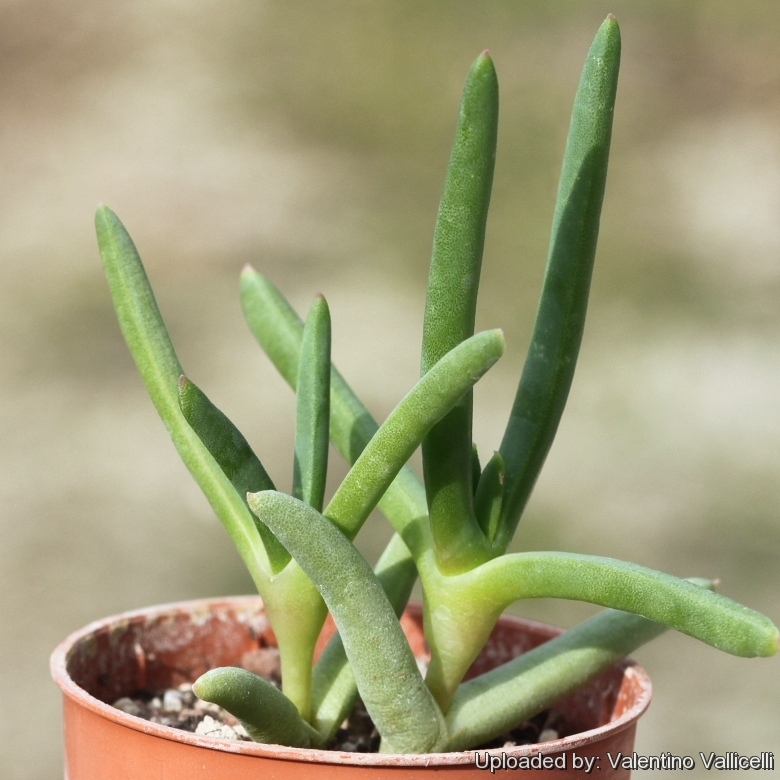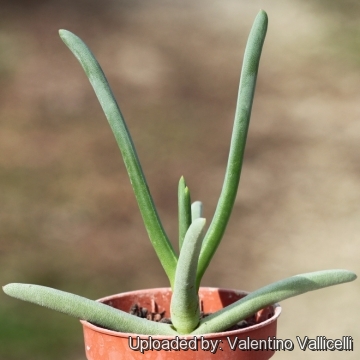




Your support is critical to our success.
Accepted Scientific Name: Cephalophyllum alstonii Marloth ex L. Bolus
S. African Gard. 18: 156 1928

Origin and Habitat: Ceres, Western Cape, South Africa.
Habitat end ecology: Cephalophyllum alstoniiSN|26023]]SN|26023]] grows in shrubby rather dense associations with many succulents, on the east side of the Ceres Mountains, on Table Sandstone of the Witteberg group. Precipitation about 100 to 350 mm rainfall p.a. in winter. It cannot tolerate heavy frost and does best in areas of low rainfall.
Synonyms:
- Cephalophyllum alstonii Marloth ex L. Bolus
- Mesembryanthemum alstonii Marloth
Cephalophyllum alstonii Marloth ex L. Bolus
S. African Gard. 18: 156 1928
Synonymy: 3
- Cephalophyllum alstonii Marloth ex L. Bolus
- Mesembryanthemum alstonii Marloth
- Cephalophyllum franciscii L. Bolus
ENGLISH: Red Spike Ice Plant
AFRIKAANS (Afrikaans): Rankvygie
Description: Cephalophyllum alstoniiSN|26023]]SN|26023]] is well worth cultivating, considering it produces some of the finest flowers known in the Mesembryanthemaceae family, and is probably the most beautiful “vygie” of all. The flowers are a vibrant ruby-purple colour with violet stamens and their size ranging to a remarkable 8-10 cm in diameter.
Habit: Cephallophyllum alstonii is a shortly trailing perennial succulent, up to 10 cm tall and 1 meter in diameter. The plants grow rather compact, but lose their shape with age producing straggly branches.
Stems: Over 50 cm long, prostrate. The long internodes connect tufts of leaves, the stem rooting at intervals.
Leaves: Very long, cylindrical/triangular, 60-120 mm long and up to 8 mm in diameter, always erect, whitish-grey and the surface is smooth throughout.
Inflorescence: Long in rich cymes.
Flowers: Bright red-purple, daisylike, 5-8(-10) cm in diameter, anthers reddish-brown.
Blooming season: Winter to spring. (September and October are the months when the flowers are at their prolific best in habitat.) The flowers open mainly at midday and in the afternoon to attract insect pollinators. They last for a few days. Flowers will only open in bright sun. At night or during cloudy days, they remain closed.
Fruits: Stalk persistent, less than 50 mm broad with 18-20 locules, with large closing bodies, broad valve wings and covering membranes with thick distal closing bulges. The dispersal of seed is closely related to the opening of the capsule through moisture. The seeds are expelled from the locules, triggered by rain, when conditions for germination of seedlings are favourable.
Seeds: Smooth, small, pear-shaped, brown, 0.75 mm long, 0.55 mm broad.
Chromosome number: 2n = 18.
Note: Within the genus, C. alstonii is well separated from other species by its bright red flowers of up to 80 mm in diameter, the persistent fruit stalks, and the smooth seeds.
Bibliography: References and further reading
1) Oliver, I.B. “Grow succulents.” Kirstenbosch Gardening Series. National Botanical Institute, Cape Town.
2) Smith, G.F., Chesselet, P., Van Jaarsveld, E.J., Hartmann, H., Hammer, S., Van Wyk, B-E., Burgoyne, P., Klak, C. & Hubert, K. “Mesembs of the world.” National Botanical Institute, Pretoria.1998.
3) Doreen Court “Succulent Flora of Southern Africa” CRC Press, 01/giu/2000
4) Heidrun E. K. Hartmann “Aizoaceae: A-E” Springer, 2001
5) www.plantzafrica.com/plantcd/cephalalston.htm
6) James Cullen, Sabina G. Knees, H. Suzanne Cubey “The European Garden Flora Flowering Plants: A Manual for the Identification of Plants Cultivated in Europe, Both Out-of-Doors and Under Glass - Casuarinaceae to Aristolochiaceae” Cambridge University Press, 11/ago/2011
7) Hermann Jacobsen, Vera Higgins “Succulent Plants: Description, Cultivation and Uses of Succulent Plants, Other Than Cacti” Williams and Norgate, Limited, 1935
8) Jacobsen. “Handbook of succulent plants” 1328 (1960)
9) H. Herre “The genera of the Mesembryanthemaceae” Tafelberg-Uitgewers Beperk, 1971
10) Gideon Smith u.a. (Hrsg.): “Mesembs of the World: Illustrated Guide to a Remarkable Succulent Group.” Briza Publications, 1998
11) Nicholas Edward Brown “Mesembryanthemum and allied genera.” In: Journal of Botany, British and Foreign. Band 66, 1928, S. 171.
12) Heidrun E. K. Hartmann: “Monographien der Subtribus Leipoldtiinae. VIII. Monographie der Gattung Cephalophyllum (Mesembryanthemaceae).” In: Mitteilungen aus dem Institut für Allgemeine Botanik Hamburg. Volume 22, 93–187 1988.
13) Heidrun E. K. Hartmann: “Notes on the genus Cephalophyllum: chromosome numbers in the genus Cephalophyllum N.E.Br. (Mesembryanthemaceae).” In: Cactus and succulent journal volume 58, Number 6, 263–266, 1986
14) Heidrun E. K. Hartmann: “Zur Biologie und Taxonomie des Cephalophyllum curto-phyllum-Komplexes (Mesembryanthemaceae). (Beitrage zur Gattung Cephalophyllum. IV).” In: Mitteilungen aus dem Institut für Allgemeine Botanik Hamburg. Volume 19, 141–163. 1984.
15) Heidrun E. K. Hartmann: “Interaction of ecology, taxonomy and distribution in some Mesembryanthemaceae.” In: Bothalia. volume 14, Number 3-4, 653–659. 1983.
16) Heidrun E. K. Hartmann: “Zur Kenntnis der Gattung Cephalophyllum N.E.Br.” In: Botanische Jahrbücher für Systematik volume 99, Number 2/3, 264–302. 1978.

Mesembryanthemum alstonii (Cephalophyllum alstonii) Photo by: Valentino Vallicelli
The gallery now contains thousands of pictures, however it is possible to do even more. We are, of course, seeking photos of species not yet shown in the gallery but not only that, we are also looking for better pictures than those already present. Read More...
Cultivation and Propagation: Cephalophyllum alstoniiSN|26023]]SN|26023]] is most active in winter, but in favourable growing conditions it keeps going over the summer too and doesn't need particular care. In cultivation Cephalophyllum alstoniiSN|26023]]SN|26023]] seems to prefer a fairly dry rest in winter but grows whenever watered. In very dry warm regions these succulents make very impressive out door ground covers. The spectacular, brightly coloured blood-red flowers attract insects when the flowers open.
Growing rate: It is vigorous and quick-growing, speedily forming lateral shoots and low mats.
Soil: Requires good drainage as it it is prone to root rot. It can grows outdoor in sunny, dry, rock crevices (protection against winter wet is required) It can also be cultivated in alpine house, in poor, drained soil.
Fertilization: Feed it once during the growing season with a fertilizer specifically formulated for cactus succulents (poor in nitrogen), including all micro nutrients and trace elements diluted to ½ the strength recommended on the label. It thrives in poor soils and need a limited supplies of fertilizer to avoid the plants developing excess vegetation, which is easily attacked by fungal diseases.
Watering: They are not at all delicate and can take some water year-round. Water minimally in winter, only when the plant starts shrivelling, water more abundantly when they are growing in the spring, but let the soil dry between soaking. During summer, they still need some water eventhough they are somewhat dormant. If grown in a container, bottom watering by immersing the container is recommended. It must have very dry atmosphere.
Light: It needs a bright sunny or light shade exposure in winter, but keep cool and partially shaded in summer.
Hardiness: It prefer a very bright situation and require a minimum temperature 5°C, but can be cool to cold and dry in the dead of winter. The earlier in the year they are planted, the better the chances for winter survival. True with many of the Mesembryanthemaceae.
Maintenance: Pinch off spent flowers to encourage more blooms.
Uses: This popular, water-wise garden plan is an excellent plant for container growing. It always looks good and stays small. It look fine in a cold greenhouse and frame or outdoor in a rockery. In the garden this plant is used best with other succulents such as Cotyledon orbiculataSN|492]]SN|492]] (pig's ears), Dorotheanthus bellidiformis (bokbaai vygies) and Cheiridopsis acuminata, which makes a striking display. It is also successfully used to prevent soil erosion, thus stabilizing the exposed ground. On farms, the leaves serve as a source of food for sheep.
Pests & diseases: Cephalophyllum alstoniiSN|26023]]SN|26023]] may be attractive to a variety of insects, but plants in good condition should be nearly pest-free, particularly if they are grown in a mineral potting-mix, with good exposure and ventilation. Nonetheless, there are several pests to watch for:
- Red spiders: Red spiders may be effectively rubbed up by misting the plants every day.
- Mealy bugs: Mealy bugs occasionally develop aerial into the new leaves and flowers with disfiguring results, but the worst types develop underground on the roots and are invisible except by their effects.
- Sciara Flies: Sciara flies are one of the major problems for seedlings. It is a good practice to mulch your seedlings with a layer of grit, which will strongly discourage the flies.
- Scales, thrips and aphids: This insects are rarely a problem.
- Rot: They appear more susceptible to mould in wetter conditions than most other species in the genus.
Propagation: It is very quick and easy to start from seed or cuttings. Seeds germinate in 7-14 days at 21°C in spring. To make a cutting twist off a branch with at least a part of roots and permit it to dry out a couple of days, lay it on the soil and insert the stem end partially into the soil. Try to keep the cutting somewhat upright so that the roots are able to grow downward. To enhance rooting success use a rooting hormone powder.
| Your Actions | |
|---|---|
| Back to Mesembryanthemum index | |
| Back to Aizoaceae index | |
 |
Back to Succulents Encyclopedia index |
Privacy stantement - Terms and conditions - How to cite - About us - Feedback - Donate



